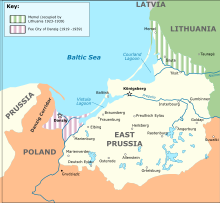| East Prussia Ostpreußen (German) | |||||||||||||||||||
|---|---|---|---|---|---|---|---|---|---|---|---|---|---|---|---|---|---|---|---|
| Province of Prussia | |||||||||||||||||||
| 1772–1829 1878–1945 | |||||||||||||||||||
 East Prussia (red), within the Kingdom of Prussia, within the German Empire, as of 1878 | |||||||||||||||||||
 East Prussia after the First World War | |||||||||||||||||||
| Anthem | |||||||||||||||||||
| Ostpreußenlied "Song of East Prussia" (1930—1945) | |||||||||||||||||||
| Capital | Königsberg | ||||||||||||||||||
| Demonym | East Prussian | ||||||||||||||||||
| Area | |||||||||||||||||||
• 1905 | 36,993 km2 (14,283 sq mi) | ||||||||||||||||||
| Population | |||||||||||||||||||
• 1905 | 2,030,174 | ||||||||||||||||||
| History | |||||||||||||||||||
| 31 January 1772 | |||||||||||||||||||
• Province of Prussia | 3 December 1829 | ||||||||||||||||||
• Province restored | 1 April 1878 | ||||||||||||||||||
| 1 August 1945 | |||||||||||||||||||
| Political subdivisions | Gumbinnen Königsberg Allenstein (from 1905) West Prussia (1922–1939) Zichenau (from 1939) | ||||||||||||||||||
| |||||||||||||||||||
| Today part of | |||||||||||||||||||
East Prussia[Note 1] was a province of the Kingdom of Prussia from 1772 to 1829 and again from 1878 (with the Kingdom itself being part of the German Empire from 1871); following World War I it formed part of the Weimar Republic's Free State of Prussia, until 1945. Its capital city was Königsberg (present-day Kaliningrad). East Prussia was the main part of the region of Prussia along the southeastern Baltic Coast.[1]
The bulk of the ancestral lands of the Baltic Old Prussians were enclosed within East Prussia. During the 13th century, the native Prussians were conquered by the crusading Teutonic Knights. After the conquest the indigenous Balts were gradually converted to Christianity. Because of Germanization and colonisation over the following centuries, Germans became the dominant ethnic group, while Poles and Lithuanians formed sizeable minorities. From the 13th century, the region of Prussia was part of the monastic state of the Teutonic Knights. After the Second Peace of Thorn in 1466 it became a part of the Kingdom of Poland, either directly (Warmia) or as a fief (remainder). In 1525, with the Prussian Homage, the territory became the Duchy of Prussia, a vassal duchy of Poland.[2] The Old Prussian language had become extinct by the 17th or early 18th century.[3]
Because the duchy was outside of the core Holy Roman Empire, the prince-electors of Brandenburg were able to proclaim themselves King beginning in 1701. After the annexation of most of western Royal Prussia in the First Partition of Poland in 1772, eastern (ducal) Prussia was connected by land with the rest of the Prussian state and was reorganized as a province the following year. Between 1829 and 1878, the Province of East Prussia was joined with West Prussia to form the Province of Prussia. The Polish and Lithuanian populations were subjected to Germanisation policies, and later to outright persecution.
The Kingdom of Prussia became the leading state of the German Empire after its creation in 1871. However, the Treaty of Versailles following World War I granted West Prussia to Poland and made East Prussia an exclave of Weimar Germany (the so-called Polish Corridor separated East Prussia from the rest of Germany), while the Memel Territory, part of the Lithuania Minor region, was detached and annexed by Lithuania in 1923. Following Nazi Germany's defeat in World War II in 1945, war-torn East Prussia was divided at Joseph Stalin's insistence between the Soviet Union (the Kaliningrad Oblast became part of the Russian SFSR, and the constituent counties of the Klaipėda Region in the Lithuanian SSR) and the People's Republic of Poland (the Warmian-Masurian Voivodeship).[4] The capital city Königsberg was renamed Kaliningrad in 1946. The German and the Masurian population of the province was largely evacuated during the war or expelled shortly afterwards in the expulsion of Germans after World War II. An estimated 300,000 died either in wartime bombing raids, in the battles to defend the province, through mistreatment by the Red Army, or from hunger, cold and disease.[5]
Cite error: There are <ref group=Note> tags on this page, but the references will not show without a {{reflist|group=Note}} template (see the help page).
- ^ The Columbia Encyclopedia, Sixth Edition (2008), East Prussia Archived 4 June 2011 at the Wayback Machine
- ^ Schaitberger, L. "Ostpreußen: The Great Trek". Archived from the original on 3 March 2023. Retrieved 8 December 2016.
- ^ Encyclopædia Britannica: Old-Prussian-language Archived 16 May 2008 at the Wayback Machine; Gordon, Raymond G., Jr. (ed.): Ethnologue: Languages of the World, 2005, Prussian Archived 22 November 2024(Date mismatch)(Timestamp date length) at the Wayback Machine
- ^ [email protected]. "Sarmatian Review XV.1: Davies". Retrieved 8 December 2016.
- ^ Andreas Kossert, Ostpreußen. Geschichte und Mythos, 2007 Pantheon Verlag, PDF edition, p. 342. According to Kossert East Prussia lost about 511,000 out of 2,490,000 inhabitants, thereof 311,000 civilians.

